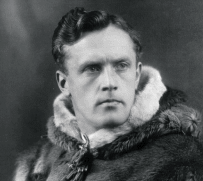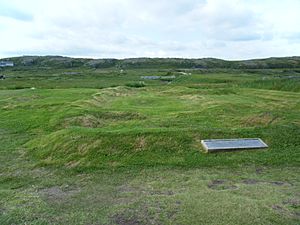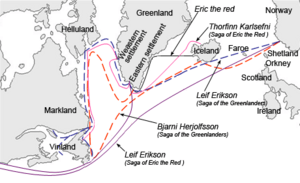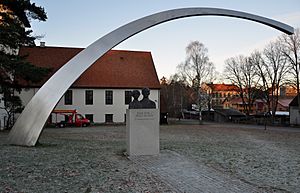Helge Ingstad facts for kids
Quick facts for kids
Helge Ingstad
|
|
|---|---|

Ingstad in his trapper days in the late 1920s (photo taken 1932 from his book about Canada The Land of Feast and Famine, 1933)
|
|
| 2nd Governor of Svalbard Acting |
|
| In office 28 July 1933 – 1 September 1935 |
|
| Monarch | Haakon VII |
| Prime Minister | Johan Ludwig Mowinckel Johan Nygaardsvold |
| Preceded by | Johannes Gerckens Bassøe |
| Succeeded by | Wolmar Tycho Marlow |
| Governor of Erik the Red's Land | |
| In office 1932–1933 |
|
| Monarch | Haakon VII |
| Prime Minister | Peder Kolstad Jens Hundseid Johan Ludwig Mowinckel |
| Preceded by | Position established |
| Succeeded by | Position abolished |
| Personal details | |
| Born | 30 December 1899 Meråker |
| Died | 29 March 2001 (aged 101) Diakonhjemmet Hospital, Oslo |
| Spouse | Anne Stine Ingstad |
| Children | Benedicte Ingstad |
| Alma mater | University of Oslo Faculty of Law |
Helge Marcus Ingstad (born December 30, 1899 – died March 29, 2001) was a famous Norwegian explorer. He is best known for proving that Vikings reached North America long before Christopher Columbus.
In 1960, Helge Ingstad and his wife, archaeologist Anne Stine Ingstad, found the remains of a Viking settlement. This important discovery was made at L'Anse-aux-Meadows in Newfoundland, Canada. Their findings showed that Norsemen like Leif Erikson had crossed the Atlantic Ocean around 500 years before Columbus. Helge Ingstad lived to be 101 years old.
Contents
Who Was Helge Ingstad?
Helge Ingstad was born in Meråker, Nord-Trøndelag, Norway. His father, Olav Ingstad, was an engineer. His family moved to Bergen in 1915.
Helge studied law and became a lawyer in 1922. He worked in Levanger for a while.
From Lawyer to Explorer
Even though he was a lawyer, Helge loved the outdoors. In 1926, he sold his law practice. He then traveled to Canada's Northwest Territories to become a trapper.
For three years, he lived with a local Indigenous group called the Caribou Eaters. When he returned to Norway, he wrote a popular book about his adventures. It was called Pelsjegerliv in Norwegian, and The Land of Feast and Famine in English.
Governor in the Arctic
Helge Ingstad also worked as a governor in the Arctic. From 1932 to 1933, he was the governor (Sysselmann) of Erik the Red's Land. This was an area in eastern Greenland that Norway had claimed.
However, an international court decided that the land belonged to Denmark. So, Norway had to leave. After this, Ingstad became the governor of Svalbard. This job was perfect for him because of his law background and his experience living in the Arctic.
Helge and Anne Stine Ingstad
While working in Svalbard, Helge met Anne Stine Moe. She was almost 20 years younger than him. Anne Stine admired Helge's books and wrote to him. They soon fell in love and married in 1941.
In 1946, the Ingstads made their home near Holmenkollen in Oslo, Norway. They lived there when they were not traveling the world. They had one daughter, Benedicte, who became a professor. Benedicte often joined her parents on their exciting journeys.
Helge Ingstad's Books
Helge Ingstad was a very popular writer. His books about his travels to faraway places made him famous in Norway.
- From Greenland, he wrote Øst for den store bre (meaning "East of the Great Glacier").
- From Svalbard, he wrote Landet med de kalde kyster (meaning "The Land With the Chilly Coasts").
- He also visited the Apache Indians in Mexico. He wrote Apache-indianerne - jakten på den tapte stamme (meaning "The Apaches - The Hunt for the Lost Tribe").
- After World War II, he lived with the Nunamiut people in Alaska. He wrote Nunamiut - blant Alaskas innlandseskimoer (meaning "Nunamiut - Inland Eskimos of Alaska").
His book The Land of Feast or Famine was republished in 1992.
Discovering the Viking Settlement

In 1960, Helge Ingstad made his most important discovery. He found the remains of a Viking settlement at L'Anse-aux-Meadows in Newfoundland, Canada. This is the only known Viking village in North America outside of Greenland.
This site dates back to around the year 1000. It is important because it proves that Vikings reached North America before Columbus. It might also be connected to Vinland, a land mentioned in old Viking stories.
What Was Found at L'Anse aux Meadows?
Archaeologists, led by Anne Stine Ingstad, excavated the site in the 1960s. They found the remains of eight buildings. These buildings were likely made of sod (turf) over a wooden frame.
The buildings included homes and workshops. One workshop was an iron smithy where iron was worked. Another was a carpentry workshop. They also found a special area for boat repair.
Other items found included:
- A stone oil lamp
- A whetstone (for sharpening tools)
- A bronze pin
- A bone knitting needle
- Part of a spindle (used for spinning thread)
The presence of the needle and spindle suggests that women lived there too. They also found butternuts, which grow much farther south. This means the Vikings traveled south to get them. Archaeologists believe the Vikings lived at this site for only a short time.

Viking Stories and Vinland
Old Norse sagas are written stories based on older oral traditions. Two important sagas, the Saga of the Greenlanders and the Saga of Erik the Red, tell about Norse people from Greenland who explored lands west of Greenland. They called this land Vinland.
The sagas suggest that the Viking settlement in Vinland failed. This was due to conflicts among the Norse people themselves. There were also conflicts with the native people they met, whom they called Skrælingar.
Today, many experts believe that L'Anse aux Meadows was not Vinland itself. Instead, it was likely an exploration base or winter camp. From here, Vikings would travel south into the Gulf of Saint Lawrence. The sagas mention settlements like Leifsbudir and Hóp, which might refer to the L'Anse aux Meadows site.
Places Named After Helge Ingstad
Two places in North America are named after Helge Ingstad:
- In Canada, a small river called Ingstad Creek flows into Great Slave Lake.
- In Alaska, a mountain called Ingstad Mountain (1461 meters high) was named after him. The Nunamiut tribe suggested the name to thank him for his help.
Helge Ingstad also worked to save the culture of the Nunamiut people. He categorized and wrote notes for many photos and audio recordings he made in 1950. This work resulted in a book and CD called Songs of the Nunamiut. His recordings are very important because much of that culture's music was lost elsewhere.
Awards and Recognition
Helge Ingstad received many honors for his work:
- He was an honorary member of the Norwegian Academy of Science and Letters.
- He received honorary doctorates from the University of Oslo, Memorial University of Newfoundland in Canada, and St. Olaf College in Minnesota.
- He was awarded the Grand Cross of the Royal Norwegian Order of St. Olav.
- He was a Knight of the Order of Vasa.
- He received the Norwegian Red Cross Badge of Honour for his help in Finnmark during World War II.
- From 1970, he received a lifetime grant from the Norwegian government.
- He was featured in two documentaries: The Man Who Discovered America (1981) and The Vinland Mystery (1984).
- In 1986, he received the Arts Council Norway's honor award.
- A Norwegian naval frigate, HNoMS Helge Ingstad (F313), was named after him.
- An asteroid called 8993 Ingstad was named in his memory in 2002.
- The Helge and Anne Stine Ingstad Building at Memorial University is named after him and his wife.
Books by Helge Ingstad
- Ingstad, Helge; Gay-Tifft, Eugene (translator) (1992). The Land of Feast and Famine. McGill-Queens University Press. ISBN: 0-7735-0912-7.
- Ingstad, Helge; Naomi Walford (translator) (1966). Land under the Pole Star; a voyage to the Norse settlements of Greenland and the saga of the people that vanished. St. Martins Press.
- Ingstad, Helge (1996). Oppdagelsen av det nye land. J. M. Stenersens forlag (Oslo).
- Ingstad, Helge; Ingstad, Anne Stine (2001). The Viking Discovery of America: The Excavation of a Norse Settlement in L'Anse Aux Meadows, Newfoundland. Checkmark Books. New York. ISBN: 0-8160-4716-2.
- Ingstad, Helge; Groven, Eivind (transcriptions); Tveit, Sigvald (ed.) (1998). Songs of the Nunamiut. Oslo: Universitetsforlaget. ISBN: 82-518-3778-2.
- Ingstad, Helge (1965). Vesterveg til Vinland; oppdagelsen av norrøne boplasser i Nord-Amerika. Gyldendal (Oslo).
- Ingstad, Helge (1954) Nunamiut; Among Alaska's Inland Eskimos New York: W.W. Norton
- Ingstad, Helge (1939) Apache Indianerne - Jakten på den tapte stamme (translated by Janine K. Stenehjem (2004) Apaches - the search for the lost tribe University of Nebraska Press)
- Ingstad, Helge; (1935) Ost For Den Store Bre Gyldendal Norsk Forlag, Oslo. (translated by Gay-Tifft, Eugene (1937) East of the Great Glacier Alfred A Knopf, Inc.)
Articles
- Ingstad, Helge. "Vinland Ruins Prove Vikings Found the New World." National Geographic, November 1964. Microsoft Encarta 2009. © 1993–2008 Microsoft Corporation. All rights reserved.
See also
 In Spanish: Helge Ingstad para niños
In Spanish: Helge Ingstad para niños



